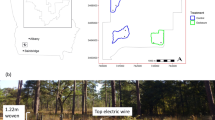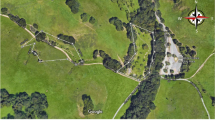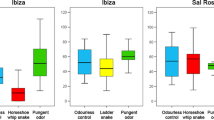Abstract
A diverse range of prey taxa exhibit stereotyped antipredator behaviors when confronting live predators. Predator cues also elicit antipredator responses, and previous research indicates that prey possess mechanisms to discriminate between the relative risk posed by particular predator cues, which mediates their investment in antipredator behaviors (i.e., “threat-sensitive” behavior). However, the salience of such predator cues may change according to perceived predation risk, which can vary temporally or spatially. We hypothesized that prey modify responses to predatory cues according to their recent experience with predators, which would prime prey to attend to predator-related cues. In the present study, we found that recent encounters with live tethered rattlesnakes increased perceived predation risk in free-ranging California ground squirrels (Otospermophilus beecheyi), leading to concomitant increases in the intensity of antipredator behaviors displayed toward a predator model. The increase in antipredator behavior following snake encounters was higher toward the predator model than a novel object, suggesting that squirrels exhibit threat-sensitive responses toward objects resembling predators. However, squirrels did not treat either of these objects with caution, nor did they differ in antipredator behavior, when presented with the model or novel object when no live snake was encountered. This suggests that increased vigilance following predator encounters modulates responses to predator cues. Such increases in antipredator behavior could assist in detecting nearby predators quickly but could also have indirect effects on prey.
Significance statement
Underresponding to predators could lead to death, while overresponding could reduce time spent on other fitness-related activities. Prey balance these costs by using environmental cues to modify antipredator responses. Detecting a live predator in the environment could indicate that the chance of predation is high, which may enhance preys’ antipredator responses. We show that ground squirrels significantly enhance antipredator behaviors toward snake models and novel objects after encountering a live tethered rattlesnake predator. However, the predator model elicited greater antipredator behavior than the novel object following snake encounters, suggesting that squirrels are primed to attend to predator-related cues in this context. Both objects were treated similarly, and with less caution, when no snake was detected. Vigilance following predator interactions therefore mediates threat-sensitive responses to subsequent predator cues.



Similar content being viewed by others
References
Abrams PA (2000) The evolution of predator-prey interactions: theory and evidence. Annu Rev Ecol Syst 31:79–105
Apfelbach R, Blanchard CD, Blanchard RJ, Hayes RA, McGregor IS (2005) The effects of predator odors in mammalian prey species: a review of field and laboratory studies. Neurosci Biobehav Rev 29:1123–1144
Arenz C, Leger D (2000) Antipredator vigilance of juvenile and adult thirteen-lined ground squirrels and the role of nutritional need. Anim Behav 59:535–541
Atherton JA, McCormick MI (2015) Active in the sac: damselfish embryos use innate recognition of odours to learn predation risk before hatching. Anim Behav 103:1–6
Baldellou M, Peter Henzi S (1992) Vigilance, predator detection and the presence of supernumerary males in vervet monkey troops. Anim Behav 43:451–461
Barbour MA, Clark RW (2012) Ground squirrel tail-flag displays alter both predatory strike and ambush site selection behaviours of rattlesnakes. Proc R Soc Lond B 279:3827–3833
Basile BM, Hampton RR (2013) Monkeys show recognition without priming in a classification task. Behav Process 93:50–61
Blough PM (1989) Attentional priming and visual search in pigeons. J. Exp. Psychol. Anim. Behav. Process. 15:358–365
Blough PM (1991) Selective attention and search images in pigeons. J. Exp. Psychol. Anim. Behav. Process. 17:292–298
Boellstorff DE, Owings DH (1995) Home range, population structure, and spatial organization of California ground squirrels. J Mammal 76:551–561
Bolker BM, Brooks ME, Clark CJ et al (2009) Generalized linear mixed models: a practical guide for ecology and evolution. Trends Ecol Evol 24:127–135
Bosiger YJ, Lonnstedt OM, McCormick MI, Ferrari MCO (2012) Learning temporal patterns of risk in a predator-diverse environment. PLoS One 7:e34535
Brown GE, Poirier JF, Adrian JC (2004) Assessment of local predation risk: the role of subthreshold concentrations of chemical alarm cues. Behav Ecol 15:810–815
Brown GE, Ferrari MCO, Elvidge CK, Ramnarine I, Chivers DP (2013) Phenotypically plastic neophobia: a response to variable predation risk. Proc Biol Sci 280:20122712
Caro T (2005) Antipredator defenses in birds and mammals. University of Chicago Press, Chicago
Clark RW, Tangco S, Barbour MA (2012) Field video recordings reveal factors influencing predatory strike success of free-ranging rattlesnakes (Crotalus spp.) Anim Behav 84:183–190
Coss RG (1991) Context and animal behavior III: the relationship between early development and evolutionary persistence of ground squirrel antisnake behavior. Ecol Psychol 3:277–315
Coss RG (1999) Effects of relaxed natural selection on the evolution of behavior. In: Foster SA, Endler JA (eds) Geographic variation in behavior: perspectives on evolutionary mechanisms. Oxford University Press, Oxford, pp 180–208
Coss RG, Biardi JE (1997) Individual variation in the antisnake behavior of California ground squirrels (Spermophilus beecheyi). J Mammal 78:294–310
Coss RG, Owings DH (1985) Restraints on ground squirrel antipredator behavior: adjustments over multiple time scales. In: Johnston TD, Pietrewicz AT (eds) Issues in the ecological study of learning. Lawrence Erlbaum, Hillsdale, pp 167–200
Cowlishaw G (1997) Alarm calling and implications for risk perception in a desert baboon population. Ethology 103:384–394
Downes SJ (2002) Does responsiveness to predator scents affect lizard survivorship? Behav Ecol Sociobiol 52:38–42
Elgar MA (1989) Predator vigilance and group size in mammals and birds: a critical review of the empirical evidence. Biol Rev 64:13–33
Ferrari MCO, Sih A, Chivers DP (2009) The paradox of risk allocation: a review and prospectus. Anim Behav 78:579–585
Fitch HS (1949) Study of snake populations in central California. Am Midl Nat 41:513–579
Fuchs SAG, Edinger HM, Siegel A (1985) The role of the anterior hypothalamus in affective defense behavior elicited from the ventromedial hypothalamus of the cat. Brain Res 330:93–107
Goldthwaite RO, Coss RG, Owings DH (1990) Evolutionary dissipation of an antisnake system: differential behavior by California and Arctic ground squirrels in above- and below-ground contexts. Behaviour 112:246–268
Goto K, Bond AB, Burks M, Kamil AC (2014) Visual search and attention in blue jays (Cyanocitta cristata): associative cuing and sequential priming. J Exp Psychol-Anim Learn Cogn 40:185–194
Hamer R, Lemckert FL, Banks PB (2011) Adult frogs are sensitive to the predation risks of olfactory communication. Biol Lett 7:361–363
Helfman GS (1989) Threat-sensitive predator avoidance in dameselfish-trumpetfish interactions. Behav Ecol Sociobiol 24:47–58
Helfman GS, Winkelman DL (1997) Threat sensitivity in bicolor damselfish: effects of sociality and body size. Ethology 103:369–383
Hennessy DF, Owings DH (1988) Rattlesnakes create a context for localizing their search for potential prey. Ethology 77:317–329
Hennessy DF, Owings DH, Rowe MP, Coss RG, Leger DW (1981) The information afforded by a variable signal: constraints on snake-elicited tail flagging by California ground squirrels. Behaviour 78:188–224
Hersek MJ, Owinsgs DH (1993) Tail flagging by adult california ground squirrels—a tonic signal that serves different functions for males and females. Anim Behav 46:129–138
Hettena AM, Munoz N, Blumstein DT (2014) Prey responses to predator’s sounds: a review and empirical study. Ethology 120:427–452
Heynen AJ, Sainsbury RS, Montoya CP (1989) Cross-species responses in the defensive burying paradigm: a comparison between Long-Evans rats (Rattus norvegicus), Richardson’s ground squirrels (Spermophilus richardsonii), and thirteen-lined ground squirrels (Catellus tridecemlineatus). J Comp Psychol 103:184–190
Hughes NK, Korpimäki E, Banks PB (2010) The predation risks of interspecific eavesdrop**: weasel–vole interactions. Oikos 119:1210–1216
Kotler BP, Blaustein L, Brown JS (1992) Predator facilitation: the combined effect of snakes and owls on the foraging behavior of gerbils. Ann Zool Fenn 29:199–206
Kotler BP, Brown JS, Slotow RH, Goodfriend WL, Strauss M (1993) The influence of snakes on the foraging behavior of gerbils. Oikos 67:309
Leger DW, Owings DH, Coss RG (1983) Behavioral ecology of time allocation in California ground squirrels (Spermophilus beecheyi): microhabitat effects. J Comp Psychol 97:283–291
Lima SL (2002) Putting predators back into behavioral predator–prey interactions. Trends Ecol Evol 17:70–75
Lima SL, Bednekoff PA (1999a) Back to the basics of antipredatory vigilance: can nonvigilant animals detect attack? Anim Behav 58:537–543
Lima SL, Bednekoff PA (1999b) Temporal variation in danger drives antipredator behavior: the predation risk allocation hypothesis. Am Nat 153:649–659
Lima SL, Dill LM (1990) Behavioral decisions made under the risk of predation: a review and prospectus. Can J Zool 68:619–640
MacLean SA, Bonter DN (2013) The sound of danger: threat sensitivity to predator vocalizations, alarm calls, and novelty in gulls. PLoS One 8:e82384
Mateo JM (2007) Ecological and hormonal correlates of antipredator behavior in adult Belding’s ground squirrels (Spermophilus beldingi). Behav Ecol Sociobiol 62:37–49
McCue MD (2007) Western diamondback rattlesnakes demonstrate physiological and biochemical strategies for tolerating prolonged starvation. Physiol Biochem Zool 80:25–34
Miller JRB, Ament JM, Schmitz OJ (2014) Fear on the move: predator hunting mode predicts variation in prey mortality and plasticity in prey spatial response. J Anim Ecol 83:214–222
Mogali SM, Saidapur SK, Shanbhag BA (2012) Tadpoles of the bronze frog (Rana temporalis) assess predation risk before evoking antipredator defense behavior. J Ethol 30:379–386
Monclús R, Rödel HG, von Holst D (2006) Fox odour increases vigilance in European rabbits: a study under semi-natural conditions. Ethology 112:1186–1193
Němec M, Syrová M, Dokoupilová L, Veselý P, Šmilauer P, Landová E, Lišková S, Fuchs R (2015) Surface texture and priming play important roles in predator recognition by the red-backed shrike in field experiments. Anim Cogn 18:259–268
Owings DH, Coss RG (1977) Snake mobbing by California ground squirrels: adaptive variation and ontogeny. Behaviour 62:50–69
Owings DH, Borchert M, Virginia R (1977) The behaviour of California ground squirrels. Anim Behav 25:221–230
Owings DH, Coss RG, Mckernon D, Rowe MP, Arrowood PC (2001) Snake-directed antipredator behavior of rock squirrels (Spermophilus variegatus): population differences and snake-species discrimination. Behaviour 138:575–595
Pink M, Abrahams MV (2016) Temperature and its impact on predation risk within aquatic ecosystems. Can J Fish Aquat Sci 876:869–876
Preisser EL, Bolnick DI, Benard MF (2005) Scared to death? The effects of intimidation and consumption in predator–prey interactions. Ecology 86:501–509
Preisser EL, Orrock JL, Schmitz OJ (2007) Predator hunting mode and habitat domain alter nonconsumptive effects in predator-prey interactions. Ecology 88:2744–2751
Preston DB, Forstner MRJ (2015) Aggregation status and cue type modify tadpole response to chemical cues. J Fish Wildl Manag 6:199–207
Putman BJ, Clark RW (2015) The fear of unseen predators: ground squirrel tail flagging in the absence of snakes signals vigilance. Behav Ecol 26:185–193
Putman BJ, Coss RG, Clark RW (2015) The ontogeny of antipredator behavior: age differences in California ground squirrels (Otospermophilus beecheyi) at multiple stages of rattlesnake encounters. Behav Ecol Sociobiol 69:1447–1457
Putman BJ, Barbour MA, Clark RW (2016) The foraging behavior of free-ranging rattlesnakes (Crotalus oreganus) in California ground squirrel (Otospermophilus beecheyi) colonies. Herpetologica 72:55–63
Randall JA, Matocq MD (1997) Why do kangaroo rats (Dipodomys spectabilis) footdrum at snakes? Behav Ecol 8:404–413
Riessen HP (2015) Water temperature alters predation risk and the adaptive landscape of induced defenses in plankton communities. Limnol Oceanogr 60:2037–2047
Roberts G (1996) Why individual vigilance declines as group size increases. Anim Behav 51:1077–1086
Rowe MP, Owings DH (1990) Probing, assessment, and management during interactions between ground squirrels and rattlesnakes. 1. Risks related to rattlesnake size and body temperature. Ethology 86:237–249
Rundus AS, Owings DH, Joshi SS, Chin E, Giannini N (2007) Ground squirrels use an infrared signal to deter rattlesnake predation. Proc. Natl. Acad. Sci. U. S. A. 104:14372–14376
Schehka S, Zimmermann E (2009) Acoustic features to arousal and identity in disturbance calls of tree shrews (Tupaia belangeri). Behav Brain Res 203:223–231
Sih A (1992) Prey uncertainty and the balancing of antipredator and feeding needs. Am Nat 139:1052
Stephenson JF (2016) Kee** eyes peeled: guppies exposed to chemical alarm cue are more responsive to ambiguous visual cues. Behav Ecol Sociobiol 70:575–584
Swaisgood RR, Rowe MP, Owings DH (2003) Antipredator responses of California ground squirrels to rattlesnakes and rattling sounds: the roles of sex, reproductive parity, and offspring age in assessment and decision-making rules. Behav Ecol Sociobiol 55:22–31
Travers M, Clinchy M, Zanette L, Boonstra R, Williams TD (2010) Indirect predator effects on clutch size and the cost of egg production. Ecol Lett 13:980–988
Wasko DK, Bonilla F, Sasa M (2014) Behavioral responses to snake cues by three species of Neotropical rodents. J Zool 292:142–150
Wasserman EA, Zentall TR (2009) Comparative cognition: experimental explorations of animal intelligence. Oxford University Press, New York
Wikenros C, Kuijper DPJ, Behnke R, Schmidt K (2015) Behavioural responses of ungulates to indirect cues of an ambush predator. Behaviour 152:1019–1040
Acknowledgements
We thank G. Anderson, S. Anthony, C. Barnes, J. Chase, T. Darragh, T. Easter, D. Fraser, M. Herr, M. Hogan, K. Huang, L. Kong, A. Maguire, E. Rebol, J. Schefski, M. Strimas-Mackey, and J. Tingle for assistance with fieldwork; M. Hamilton and E. Viik for support at the BORR field site; and four anonymous reviewers for their useful comments on previous drafts of the manuscript.
Funding information
This study was funded by San Diego State University, the Mildred E. Mathias Graduate Student Research Grant (to BJP), the Animal Behavior Society Student Research Grant (to BJP), and the National Science Foundation (DBI-0951010 to RWC).
Author information
Authors and Affiliations
Corresponding author
Ethics declarations
Conflict of interest
The authors declare that they have no conflict of interest.
Ethical approval
All applicable international, national, and/or institutional guidelines for the care and use of animals were followed. All procedures performed in studies involving animals were in accordance with the ethical standards of San Diego State University and methods were approved by the Institutional Animal Care and Use Committee (APF 13-08-015C) prior to data collection.
Data availability statement
The datasets analyzed during the current study are available as electronic supplementary material.
Additional information
Communicated by E. Korpimäki
Rights and permissions
About this article
Cite this article
Ayon, R.E., Putman, B.J. & Clark, R.W. Recent encounters with rattlesnakes enhance ground squirrel responsiveness to predator cues. Behav Ecol Sociobiol 71, 149 (2017). https://doi.org/10.1007/s00265-017-2378-1
Received:
Revised:
Accepted:
Published:
DOI: https://doi.org/10.1007/s00265-017-2378-1




